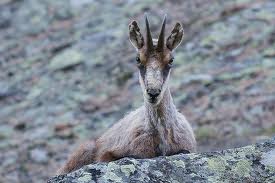Zakare Ya
Endangered Species Research
 The Apennine
Chamois is an endangered animal living in Europe. The scientific name for this
animal is Rupicapra Rupicapra Ornata. It is a goat-like mammal with a
hook-shaped horn curving backwards. Like the barren-ground caribou, this animal
changes its coat seasonally. The color of the coat in the summer is brown, but in
the winter it is darker. The length of the body is from 3.5 to 4.5 feet. An
average weight for the chamois is from 130 to 135 pounds. The length of the tail
is about 4 to 6 inches.
The Apennine
Chamois is an endangered animal living in Europe. The scientific name for this
animal is Rupicapra Rupicapra Ornata. It is a goat-like mammal with a
hook-shaped horn curving backwards. Like the barren-ground caribou, this animal
changes its coat seasonally. The color of the coat in the summer is brown, but in
the winter it is darker. The length of the body is from 3.5 to 4.5 feet. An
average weight for the chamois is from 130 to 135 pounds. The length of the tail
is about 4 to 6 inches.
The Apennine
Chamois is a solitary animal, this means that they are usually alone and apart
from each other. The Apennine usually fall prey to other animals. The predators
for this animal are wolves that are also endangered. The chamois is an
herbivore, it especially consume grasses, leaves, buds, shoots, and fungi.
 The chamois is
commonly founded in the mountains of Europe, especially the mountain ranges of
Italy. In the summer, the chamois prefers rock faces and pasture lands at
heights above 1700 meters for its habitat. In the cold winter, it likes to
retreat to the woods below. The chamois lives on hard and rocky surfaces on mountains
when it’s warm to avoid being eaten by predators.
The chamois is
commonly founded in the mountains of Europe, especially the mountain ranges of
Italy. In the summer, the chamois prefers rock faces and pasture lands at
heights above 1700 meters for its habitat. In the cold winter, it likes to
retreat to the woods below. The chamois lives on hard and rocky surfaces on mountains
when it’s warm to avoid being eaten by predators.  The current
population of the chamois is about 400,000. They were mainly hunted down by
human and dogs for its original source which is the chamois leather. Human and
dogs have greatly reduced the number of chamois population. The population
before being endangered was more than 400,000.
The current
population of the chamois is about 400,000. They were mainly hunted down by
human and dogs for its original source which is the chamois leather. Human and
dogs have greatly reduced the number of chamois population. The population
before being endangered was more than 400,000.
Human and dogs
played a major role on declination of the chamois. They were hunted close to
extinction. Humans have criticized these animals and the status of this animal
is very critical or endangered. The Abruzzo National Park intervened with a
re-introduction program, which led to the reform of the chamois in the
mountains of Italy.
No comments:
Post a Comment